
Background
Calculate the true price of your Christmas meal
What does a Christmas Dinner for eight, with prawn cocktail, lobster soup, beef roulade, potato gratin, haricots verts and ice-cream with strawberries cost at the shop? And what are the environmental costs of such a lavish and copious Christmas Dinner? A group of WUR economists calculated the meal's 'true price', which they estimated at €175. They also calculated the costs of an alternative vegetarian Christmas Dinner for eight, with beetroot carpaccio, carrot soup, Beef Wellington, chicory salad, and apples from the oven. This alternative costs only €53.50, including environmental costs.
What is the true price of your Christmas dinner per
course?
Continue reading below the image

1) Starter
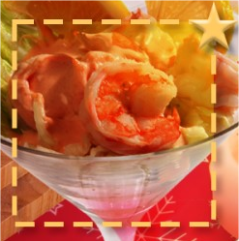
We wanted a fish starter and opted for the traditional shrimp cocktail with lettuce, mayonnaise, and lemon. The price in the shop is €26 for eight persons. The environmental costs amount to €3, bringing the real price up to €29. These costs come primarily from the shrimp; not because of overfishing, but because of the heavy fuel on which the shrimpers’ ships run, and which contributes to climate change, air pollution, and fossil fuel depletion.
Fun detail: you can also replace the lemon with lime. The two fruits have a similar function in the kitchen, but limes are grown in tropical and subtropical countries, while lemons usually come from the Mediterranean region. The climate costs of limes are therefore higher than those of lemons, but the difference in real price in this dish is limited.
An alternative starter is beet carpaccio, made from beetroot, goat cheese, rocket, and pistachio. The shop price of this starter is €10.30. The environmental impact is only €1.60, so the real price for eight persons is just under €12.
2) Soup
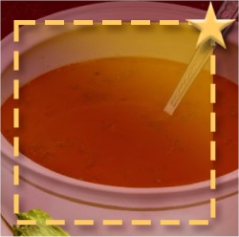
We opted for lobster soup. Homemade lobster soup costs nearly €50 euro for eight persons. The lobster usually eaten in the Netherlands at Christmastime is the American Lobster (Homarus Americanus), which comes from Canada or the US. The Eastern Scheldt lobster (Homarus gammarus) is only caught during the summer months. Lobster is not overfished in the US, but right whales can get entangled in the ropes of lobster pots. The living lobsters are flown to Europe by plane, because they have to be cooked alive. Animal welfare is therefore an issue. The lobsters are slaughtered while anaesthetised, before being cooked. We estimate the environmental costs at €15, so the real price for lobster is €65.
An alternative is a vegetarian carrot soup, with fresh carrots in coconut milk. This soup costs €3.40 in the shop, with a mere €0.40 of environmental costs, so the real price is €3.80.
3) Main course with meat
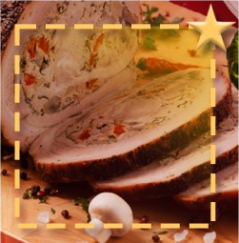
We ordered a beef roulade for eight persons. The roulade costs €42 in the supermarket, but the environmental costs amounts to €15, so the real price is €57. These costs consist mainly of livestock feed and land use, i.e. the clearing of rainforest for cattle farming and soybean production.
A more environmentally friendly meat alternative is wild boar. It costs €32 for 8 people in the supermarket, but if the wild boar is shot as part of the Veluwe's wildlife management programme, then that is also the real price. Point of attention: the availability of shot game is limited, so there are hardly any extra environmental costs while stocks last.
Another alternative is the traditional turkey, which costs €6.50 per kilo, so for €25 you have more than enough turkey for eight persons. Most turkeys are flown in from the US for Christmas, but they are a relatively sustainable alternative to beef and pork, with a slightly higher environmental impact than chicken. We don't dare to put a 'real price' on turkey for lack of data, but the environmental impact is substantially lower than for beef.
4) Vegetarian main course
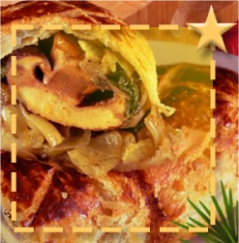
We made a vegetarian 'Beef' Wellington: a combination of pumpkin, onion, mushroom and lentils in puff pastry. The ingredients cost €14.40, and the environmental damage amounts to €1.60, so €16 is all it costs.
5) Vegetables
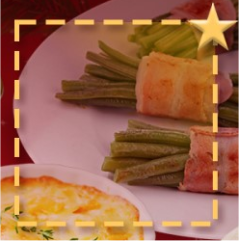
We offered a combination of vegetable side dishes. First, the potato gratin. Potatoes are a sustainable and healthy choice, as long as you don't deep-fry them. Table potatoes cost €2.90 in the shop, plus €0.50 of environmental costs. We then added cheese and cream. This brings the total price of potato gratin to €6.50 (shop) plus €1.50 of environmental costs.
Next, we had haricots verts, wrapped in bacon. Ingredients: green beans and bacon. We opted for green beans from a jar, because they are homegrown and represent much lower environmental costs than imported green beans from Egypt or Kenya. These beans cost €1.20 plus €0.50 of environmental costs. The environmental costs are due to the use of glass; frozen or canned green beans are more cost-effective in this respect. The bacon is also domestically sourced, but leads to higher environmental costs; €6.40 (shop) plus €1.40 (environment) add up to a real price of €7.80. Altogether, this dish has a real price of €9.50. Quite expensive and not really sustainable.
Alternatively, we could have a fresh endive salad. With chicory, apple, walnuts and semi-skimmed yoghurt sauce, we have a very sustainable side dish for €6 (€5.50 shop price plus €0.50 environmental costs). This is due primarily to our use of a seasonal vegetable (chicory), and Dutch apples.
6) Dessert

We took a classic: vanilla ice-cream with strawberries and chocolate. A tub of regular or vanilla ice-cream costs €2 (retail price) plus €1.15 (environmental costs, mainly due to the environmental impact of dairy). Strawberries have to come from abroad or from the greenhouse. As a result, the retail price is very high (€7.20) and there are additional environmental costs of €1.15. The chocolate costs €2 in the shop and €1 in environmental costs. All in all, an expensive and not very sustainable dish: € 11.20 in the shop and a real price of €14.50.
A sustainable alternative dessert is vanilla ice-cream with baked apples. Ingredients: Dutch apples for €2 per kilo, honey, almonds, and vanilla ice-cream. Total costs of €5.70 (shop) plus a bit over €1 of environmental costs, which makes it a lot cheaper too.
7) Beverages

To accompany our Christmas Dinner we drank wine: white wine with the starter, and red wine with the main course. We bought three bottles of relatively good wine for a total retail price of €32. To this is added €2.50 in environmental costs. The environmental costs for organic wine are lower than for non-organic wine, but both lead to land use and climate change, so the difference between organic and non-organic per bottle is limited. We also drank tap water.
This element of the meal can also be made more sustainable and economical under the motto 'drink in moderation'. The less wine and the more water we drink, the lower the costs and the more limited the environmental damage. The alternative, with lots of tap water, flavoured water (freshly squeezed orange), and one bottle of wine costs less than €10.
8) Coffee with chocolate

To end our meal, we drank some coffee with a piece of chocolate. This costs €1.5 in the shop; the real price is €2 for eight people. Both coffee and cocoa are grown in tropical countries by farmers with mostly small farms. The environmental impact includes climate change, water and air pollution, and land use. However, the social costs – low income, forced labour and child labour – are higher. Although several coffee and chocolate brands use sustainability criteria and factor them into the selling price, many producers live below the poverty line.
The Christmas Dinner team of Wageningen Economic Research consisted of researchers Willy Baltussen, Sophie Galema, Geert Hoekstra, Bas Janssens, Johanna Steketee, and Channah Durlacher (Communications). Text: Albert Sikkema, illustration: Martin Loquet.
Health
We assess how healthy our Christmas Dinner is based on the food pyramid. If we compare the standard menu with fish and meat to the alternative vegetarian menu in terms of health, we see a substantial difference. The alternative menu is far more in line with the Dutch Nutrition Centre’s guidelines concerning a healthy amount of fruits and vegetables. This recipe also contains nuts and pulses, two nutritional components that the average Dutch person eats too little of. In the standard menu, the maximum recommended amounts for red meat and alcohol are greatly exceeded. But eating according to the food pyramid does not mean never making an exception. Especially at Christmastime, there is room for products that do not fit into the nutritional ideal.
What does the food pyramid recommend?
- Eat less animal protein and more plant-based protein
- Eat seasonal produce
- Opt for sustainable products with a low social impact (low energy, fertiliser, crop protection and emissions, and no child labour)
- Avoid food waste